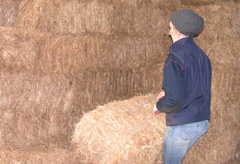
Farming is a very physical occupation and workers can injure themselves by lifting heavy loads such as chemicals, fertiliser, hay bales, buckets, equipment and animals. Most agricultural manual handling injuries involve the back and weight-bearing joints.
Injuries can happen so easily when you are lifting, pushing, pulling, carrying, lowering, holding heavy items or when you are restraining animals, handling stock, or moving equipment or hay.
Manual handling injuries occur through:
- Increased wear and tear or damage from intense or strenuous manual activity
- Gradual wear and tear from ongoing manual activity
- Heavy or awkward lifts (lifting heavy machinery or sheep onto a ute)
- Sudden, unexpected movement (stumbling, tripping or falling when carrying a heavy object).
How to minimise risk of injury
Strain injuries can keep farm workers away from work for weeks at a time, but the risk of injury can be minimised by good lifting techniques and safe working habits.
- Be mindful of your back and joints when handling stock and when lifting, pushing, pulling, carrying, lowering and holding heavy items like equipment and hay
- Use mechanical lifting aids, wheelbarrows, trolleys or get help to lift and carry heavy loads whenever possible. Try to repack big loads to a collection of smaller, lighter loads
- When lifting appropriate loads, it is important to maintain good posture and ensure correct lifting techniques are used to reduce the risk of injury
- Do not forget to warm up cold muscles and stretch before lifting
For more tips, see: Farm safety-manual handling
Find out more about this topic on Better Health Channel
Fast facts:
- Manual handling accidents and injuries are often caused by lifting heavy objects, including animals incorrectly.
- Always keep the load close to your body, bend your knees (instead of your back) and lift with your thigh muscles. Never lift with your back.
- Organise your work area to reduce the amount of bending, twisting and stretching required.
- Plan ahead. Consider the safest possible ways of lifting, carrying, holding, lowering, pushing, and pulling.
References used for this topic
More information:
Department of Commerce (WA)
Hazards on Farms
WorkSafe Victoria
Hazardous manual handling
Clinical care:
National Health and Medical Research Council
Evidence-based management of acute musculoskeletal pain: a guide for clinicians
Research & reviews:
Medical Journal of Australia
Management of chronic low back pain
Physiotherapy Canada Journal
Get ’Er Done: Experiences of Canadian Farmers Living with Chronic Low Back Disorders
|
|